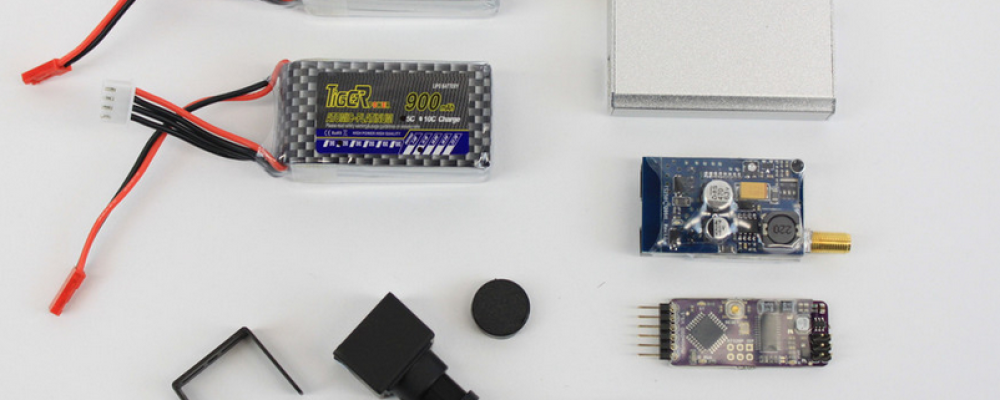Are you a first time buyer looking for your first drone? This is a great place to start. This article will help you pick the components needed to build your own UAV.
The buying decisions for DIY drones are different from a model that is ready to fly. If you are reading this article, the assumption is that you want to build your own. This will be a multi-part post with more details about the various comonents, but this is a good place to start.
You will need the following components:
1) Frame
2) Motors
3) Electronic Speed Controllers (ESCs)
4) Flight Controller
5) Batteries
6) TX/RX System
Frame
Let’s start with the frame. The frame can be either purchased or made from scratch. Typical frames for the DIY include the 3D Robotics quad frame kit , the Tarot 680 frame kit or the DJI Flamewheel 450/550 kits. These kits come with parts necessary to build the aircraft platform. This list include the base plates, the arms, the motor mounts and any additional mounting items. The DJI Flamewheel series goes even farther and includes the motors, ESC and Power Distribution board included in the kit and is a great solution for those who want to build but don’t want to select the various components.
Motors
Deciding which motors will work can be a difficult process. You need to determine what you want to carry (payload) and based on the all up weight (AUW) of the aircraft, can decide which motors you need. I recommend the T-Motor series of brushless motors because they are well made, have good bearings, and are balanced pretty well from the factory. It is possible to scrimp on the motor selection, but this can make or break your build. For the 3D Robotics kit, I recommend the 3D Robotics AC2836 – 880KV. For the Tarot 680 frame, I recommend the T-Motor MN3110-470KVmotor. It is powerful and still has a good power consumption. The DJI flamewheel kit comes with motors, so no need to select motors for that kit.
Electronic Speed Controllers (ESCs)
The electronic speed controller is necessary to drive the brushless motors. The ESC converts control signals from the flight controller into power the motor can use. The ESC is designed to drive the brushless motors and controls the speed of rotation. There are a couple of considerations when selecting speed controllers. First is the amount of amps they can handle. The number of amps necessary is dependent on the motor selected. For example, the T-Motor MN3110 motor will consume a max of approximately 30 amps of power, so we need to select an ESC that can handle at least 30 amps of power. The second consideration is the number of volts the aircraft main battery will be using. For the Tarot 650/680, I like to run 6S batteries to give the aircraft enough power to fly fast and carry a big payload. The speed controllers will typically include the minimum and maximum voltage they can handle. A third consideration is the physical size. For the Tarot 680, I need to supply 6 speed controls (one for each motor) so space is limited. I prefer to find a smaller sized speed control for this model because it makes mounting the ESC during construction easier. Typically, smaller size also means decreased weight, so small is better. I recommend theCastle 35 amp ESC for the Tarot 680 as it fulfills all the power specifications and is pretty small in size. For the 3D Robotics kit, the Castle Creations 25 amp ESC is sufficient. Another alternative is a set of ZTW 20amp ESCs. Again, the DJI Flamewheel kit includes the components already.
Flight controller
The flight controller really deserves a whole article by itself. I will recommend either the 3D Robotics Pixhawk flight controller or the DJI Naza-M flight controller. Both are effective at flying a multi-rotor aircraft and are excellent choices. The 3D Robotics Pixhawk is based on an open-source hardware and software design and is a great value. It allows out of the box autonomous flight capabilities (with the additional GPS unit), but can be more difficult to set up. The DJI Naza M is less capable, but is pretty easy to set up and fly.
Batteries
Small UAVs still consume a lot of power, and we use Lithium Polymer batteries in these aircraft because they have enough power density (powerful and light enough to fly) to fly our aircraft. For more information on batteries, please check out this article. It gives more meaningful information about batteries. For the 3D Robotics quad, I recommend a 4S, 4000mAh Lithium Polymer Battery. The Flamewheel kit would also work well with the 4S, 4000mAh battery, but if you want to mount the battery between the frame plates, you will need something like the 4S – 3000mAh battery. For the Tarot 680 frame, I really prefer to go with a larger capacity battery with more voltage, so a good choice is the 6S – 4500mAh Battery. This battery will give plenty of power and longer flight times.
TX/RX System
The TX/RX system (or radio controller) is the unit that is the interface between man and machine. The transmitter (TX) is the unit held by the pilot and has the various switches and joysticks that allow the pilot to maneuver the aircraft remotely. The receiver (RX) is the unit on the aircraft that reads those signals and translated the pilot’s actions into commands recognized by the flight controller. Most radios are defined by the number of channels it can control. So an 6 channel radio can control 6 functions on the aircraft. For a multi-rotor, the least amount of channels is 5. The functions correspond to the following: Throttle, Rudder (yaw) Aileron (Roll) and Elevator (pitch) plus a channel for selecting the flight mode. Typically a multi-rotor pilot will use more channels for functions like controlling the landing gear, triggering the failsafe, or tilting the gimbal or activating the shutter on a camera. A rule of thumb is to buy the best TX/RX system you can afford as it provides additional capabilities (more channels of control) and can be transferred from aircraft to aircraft. I have a remote that is a couple of years old and I still use it. Some of the more popular radios include the Spektrum DX9 and Futaba SG14 radios.
Hopefully this article helps the DIY select the components they need to help build their first multirotor aircraft. Autonomous Avionics can be reached at (303)371-3067 to help answer any questions and we invite you to check out the website at https://AutonomousAvionics.com for a larger selection of products.


